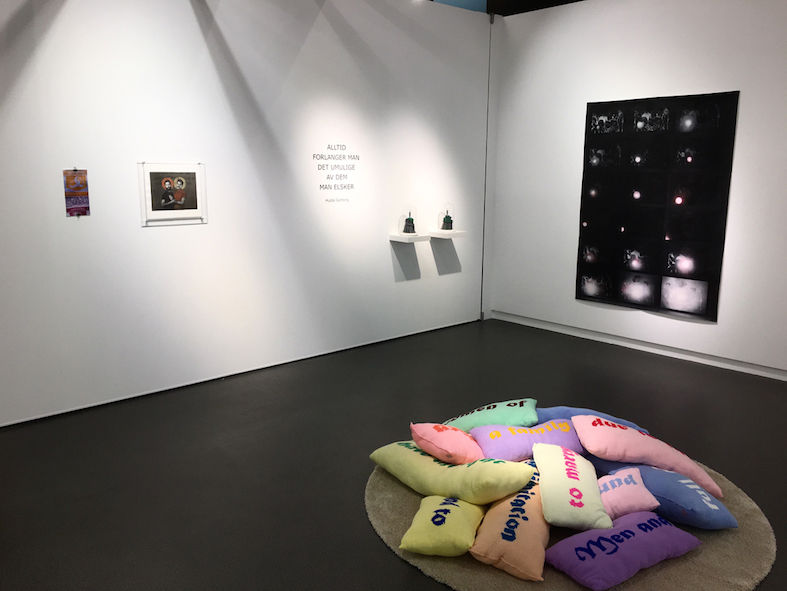Connubial
28 May – 25 September 2016
Shiva Anoshirvani
Casia Bromberg
Nigel Grimmer
Darren Jones
Harish Iyer
Guillaume Paris
Elham Rokni
Gabriel Garcia Roman
Rebecca Scott
Malin Ståhl
Saskia Olde Wolbers
Curated by Roberto Ekholm | EKCO
Garborgsenteret
Hetlandsgata 11, 4344 Bryne, Norway









The word connubial relates to marriage and the relationship between a married couple The exhibition, Connubial, brings together 10 international contemporary artists who explore, through their works, the complexities of marriage and love. The exhibition takes Hulda and Arne Garborg’s writing and philosophy on marriage, love and equality as a focal point in order to look at currents ideas of marriage as a concept
Today we expect marriage to be based purely on love but historically marriage was about conventions and financial support between a husband and wife. At times love between two people have caused divisions between families and would create political disruptions. The institution of marriage has been politically changing across the world to include LGBT couples. What has been highlighted in this fight for equality has made us reflect on what is one’s right and what is taken for granted.
In many of the art pieces in this exhibition the artists are questioning those values and draw our attentions to the space between the private and the public and where the personal becomes a centre point in a political and geographical narrative. Part of the exhibition is an original matrimonial advert. In May 2015 Harish Iyer’s mother Padma Iyer placed India’s first gay matrimonial advertisement for her son. After many newspapers refused it the Indian MidDay accepted it. Written in a traditional way, as it would have been for a heterosexual groom, the advert seems to float between a new modern society, while also existing within old traditions.
In Elham Rokni’s video piece The Wedding she uses 8mm footage from her parent’s wedding in 1978 (pre-revolutionary) Tehran. Political events had overshadowed the celebration of the marriage so much so, that none of her relatives remember the exact date they got married. Rokni uses her personal history to explore collective experiences of loss and displacement. In Gabriel García Román’s hand-printed image titled Carlos & Fernandowe’re reminded of similar relations between personal celebrations and political realities. In a celebratory almost saint like image, their personal hopes of love became wedged between a liberal and conservative stand on gay marriage. They were married in California during the 5 months that gay marriage was legal in California, before lawmakers put Proposition 8 on a special ballot legally stating that marriage was to be defined as only legal between a man and a woman.
The personal shift between dreams, hope, longing and reality is captured in a personal “love curve” sketched as a seismic wave in Shiva Anoshirvani’spiece Kärlek, När du söker skydd I en plats full av hot. The “love curve,” is a set of rhythmic markings, reflecting the timeline from her birth until present day. Here memory is condensed into abstract lines, which we view as a reading of earthly eruptions. Are these peaks of elastic shock waves moments of joy or sadness, passion or grief? Shiva does not expose what they are but visually we can feel the physical impacts through the reading of the seismic wave.
Freedom of unity or independence has been questioned throughout history. In 1888 Arne Garborg wrote “Freedom in the sense of free will should, completely, from the first day until the last, be the principle of marriage; that is the purpose.” In the photographic works by both Darren Jones and Casia Bromberg, the body is used to display physical contact, counter balances and tensions to explore relations between trust, closeness and independence. Nigel Grimmer’s piece titled Minor Monuments (Mountains) is also playfully suggesting a struggle of independence and closeness in marriage.
Rebecca Scott uses knitting to question traditional roles of women by using unexpected text or imagery for her knitting motifs. On 12 colourful cushions she has broken up the text of Article 16 of The Declaration Of Human Rights. Laid out on the floor the viewers are encouraged to piece together the fragmented text or lay down to reflect on the surrounding works such asGuillaume Paris’ text piece Resist. Here the swirling words draw you hypnotically in to his quasi-magical form of thinking on a discourse of both consumerism and western politics. Is it questioning our status quo of happiness and solace?
Marriage and relationships exists in a space between dreams and reality. In the video pieces by Malin Ståhl and Saski Olde Wolbers this ambiguous space is played out in narratives of the mundane, the fictional and the real.
In the Connubial exhibition the viewer is encouraged to reflect on the values of marriage and relationships and what it means today. The focus should not only be locally but globally. Considerations should be politically as well as personally to long, dream, and fight for your rights to love. These works ensure that relationships are seen as challenging, insightful, poetic, playful and celebratory.
